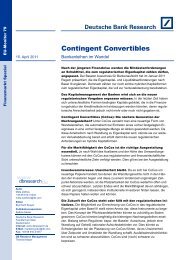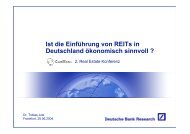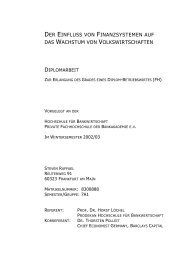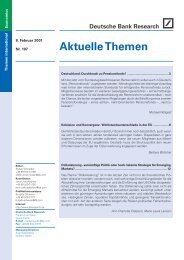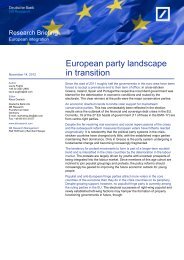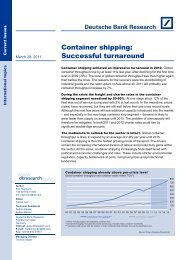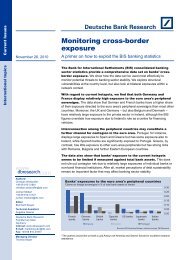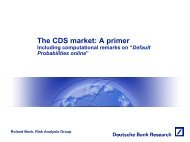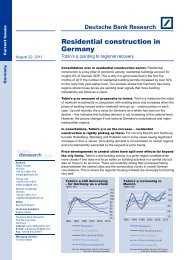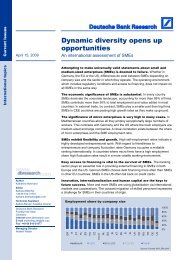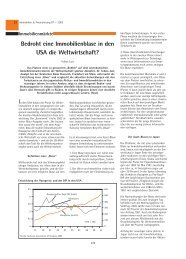Low interest rates pressuring US bank margins - Deutsche Bank ...
Low interest rates pressuring US bank margins - Deutsche Bank ...
Low interest rates pressuring US bank margins - Deutsche Bank ...
Create successful ePaper yourself
Turn your PDF publications into a flip-book with our unique Google optimized e-Paper software.
<strong>Low</strong> <strong>interest</strong> <strong>rates</strong> <strong>pressuring</strong> <strong>US</strong> <strong>bank</strong> <strong>margins</strong><br />
The current <strong>bank</strong>ing environment is not conforming to history, however. The<br />
initial benefit of low <strong>rates</strong> has waned without the concurrent growth in lending.<br />
Although funding costs continue to decline, they may not be enough to offset<br />
lower asset yields and they are approaching a limit of zero (see chart 1). With<br />
the Fed announcing no intention to raise <strong>rates</strong> until the end of 2014, this limit<br />
could quickly constrain <strong>bank</strong> profitability. Although there are indicators of a pickup<br />
in lending across recent quarters, it may not be enough to make up for the<br />
compression in net <strong>interest</strong> income. Furthermore, alternative revenue drivers<br />
like non-<strong>interest</strong> income so far have not provided much support.<br />
Funding costs on a downward trend, nearing zero bound 1<br />
%<br />
12<br />
10<br />
8<br />
6<br />
4<br />
2<br />
0<br />
84 85 86 87 88 89 90 91 92 93 94 95 96 97 98 99 00 01 02 03 04 05 06 07 08 09 10 11<br />
Sources: St. Louis Fed, FDIC<br />
Asset yields Funding costs of earning assets Fed funds rate<br />
Net <strong>interest</strong> <strong>margins</strong> (defined as net <strong>interest</strong> income over average earning<br />
assets) were 3.6% at year-end 2011, just 11% higher from the 20-year low of<br />
3.2% in the last quarter of 2006 (see chart 2). After the initial benefit from low<br />
<strong>rates</strong>, net <strong>interest</strong> <strong>margins</strong> are likely to continue to trend downwards as funding<br />
costs bottom out and asset yields continue to fall. The chart below demonst<strong>rates</strong><br />
that net <strong>interest</strong> <strong>margins</strong> spiked not only after the most recent crisis but also<br />
during previous recessionary rate environments, as evidenced during the <strong>US</strong><br />
recession in the early 1990s and again in 2001-02. In the second half of the<br />
1980s, the decline in inflation and the reduction in the Fed funds rate led to a<br />
corresponding surge in net <strong>interest</strong> <strong>margins</strong>.<br />
More precisely, it may be the shape of the yield curve (which is heavily<br />
influenced by the official <strong>interest</strong> rate) that largely determines the <strong>interest</strong><br />
margin. The spread between 10- and 2-year Treasuries demonst<strong>rates</strong> that as<br />
the yield curve flattens or becomes inverted (indicated in chart 2 by near-zero or<br />
negative values), net <strong>interest</strong> <strong>margins</strong> tend to fall. For example, at the recent net<br />
<strong>interest</strong> margin low in late-2006, the yield curve was inverted. By contrast, as<br />
spreads widen, net <strong>interest</strong> <strong>margins</strong> follow suit. The yield curve is likely to<br />
continue its flattening trend as long-term <strong>rates</strong> draw closer to short-term <strong>rates</strong>.<br />
The Fed’s recent “Operation Twist” is explicitly targeting lower long-term <strong>rates</strong>,<br />
with the intention of boosting credit volume in products that track longer-term<br />
Treasury yields such as mortgages and corporate bonds. As a result, further<br />
compressions in net <strong>interest</strong> <strong>margins</strong> are likely in the near term.<br />
2 | May 11, 2012 Research Briefing



